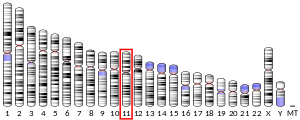OR51B2
Olfactory receptor 51B2 is a protein that in humans is encoded by the OR51B2 gene.[4]
| OR51B2 | |||||||||||||||||||||||||
|---|---|---|---|---|---|---|---|---|---|---|---|---|---|---|---|---|---|---|---|---|---|---|---|---|---|
| Identifiers | |||||||||||||||||||||||||
| Aliases | OR51B2, HOR5'Beta3, OR51B1P, olfactory receptor family 51 subfamily B member 2 (gene/pseudogene) | ||||||||||||||||||||||||
| External IDs | MGI: 1341900 HomoloGene: 56593 GeneCards: OR51B2 | ||||||||||||||||||||||||
| |||||||||||||||||||||||||
| |||||||||||||||||||||||||
| Orthologs | |||||||||||||||||||||||||
| Species | Human | Mouse | |||||||||||||||||||||||
| Entrez | |||||||||||||||||||||||||
| Ensembl |
| ||||||||||||||||||||||||
| UniProt | |||||||||||||||||||||||||
| RefSeq (mRNA) | |||||||||||||||||||||||||
| RefSeq (protein) | |||||||||||||||||||||||||
| Location (UCSC) | Chr 11: 5.32 – 5.32 Mb | n/a | |||||||||||||||||||||||
| PubMed search | [2] | [3] | |||||||||||||||||||||||
| Wikidata | |||||||||||||||||||||||||
| |||||||||||||||||||||||||
Function
Olfactory receptors interact with odorant molecules in the nose, to initiate a neuronal response that triggers the perception of a smell. The olfactory receptor proteins are members of a large family of G-protein-coupled receptors (GPCR) arising from single coding-exon genes. Olfactory receptors share a 7-transmembrane domain structure with many neurotransmitter and hormone receptors and are responsible for the recognition and G protein-mediated transduction of odorant signals. The olfactory receptor gene family is the largest in the genome. The nomenclature assigned to the olfactory receptor genes and proteins for this organism is independent of other organisms.[4]
Ligands
As of 2015, OR51B2 was an orphan receptor, meaning that no odorants have been identified which bind to it.[5]
See also
References
- GRCh38: Ensembl release 89: ENSG00000279012 - Ensembl, May 2017
- "Human PubMed Reference:". National Center for Biotechnology Information, U.S. National Library of Medicine.
- "Mouse PubMed Reference:". National Center for Biotechnology Information, U.S. National Library of Medicine.
- "Entrez Gene: OR51B2 olfactory receptor, family 51, subfamily B, member 2".
- de March CA, Ryu S, Sicard G, Moon C, Golebiowski J (September 2015). "Structure–odour relationships reviewed in the postgenomic era". Flavour and Fragrance Journal. 30 (5): 342–361. doi:10.1002/ffj.3249.
Further reading
- Bulger M, van Doorninck JH, Saitoh N, Telling A, Farrell C, Bender MA, Felsenfeld G, Axel R, Groudine M, von Doorninck JH (April 1999). "Conservation of sequence and structure flanking the mouse and human beta-globin loci: the beta-globin genes are embedded within an array of odorant receptor genes". Proceedings of the National Academy of Sciences of the United States of America. 96 (9): 5129–34. doi:10.1073/pnas.96.9.5129. PMC 21828. PMID 10220430.
- Bulger M, Bender MA, van Doorninck JH, Wertman B, Farrell CM, Felsenfeld G, Groudine M, Hardison R (December 2000). "Comparative structural and functional analysis of the olfactory receptor genes flanking the human and mouse beta-globin gene clusters". Proceedings of the National Academy of Sciences of the United States of America. 97 (26): 14560–5. doi:10.1073/pnas.97.26.14560. PMC 18958. PMID 11121057.
- Fuchs T, Malecova B, Linhart C, Sharan R, Khen M, Herwig R, Shmulevich D, Elkon R, Steinfath M, O'Brien JK, Radelof U, Lehrach H, Lancet D, Shamir R (September 2002). "DEFOG: a practical scheme for deciphering families of genes". Genomics. 80 (3): 295–302. doi:10.1006/geno.2002.6830. PMID 12213199.
External links
- OR51B2+protein,+human at the US National Library of Medicine Medical Subject Headings (MeSH)
This article incorporates text from the United States National Library of Medicine, which is in the public domain.

